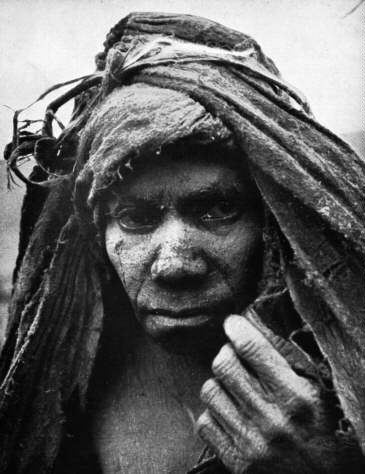
|
|
| Cannibal Culture | |
|
Selected excerpts from Jens Bjerre’s The Last Cannibals on primitive beliefs and customs New Guinea |
Cannibal Courtship and Customs (5)
Spirits and invisible powers play an important part in the life of the Kumans. When they are faced with problems they cannot explain, such as illness, madness, death, failure of crops and accidents they seek refuge in the world of fantasy and magic. They distinguish three categories of magic. There is, first, the beneficent magic which gets results, such as a love incantation which wins a wife or husband, or keeps the partner from infidelities. Another magic of this kind is practised by old women who claim to be able to produce boy births. The witch collects some plants with small roots resembling the male sex organ, and over these she croons an appropriate rigmarole as she feeds the plant to the pregnant woman. The mother must then sleep for a month with her head on a small bow and arrow so that she can dream her child into becoming a boy. Some witches declare that this magic is infallible in its results. Nearly all the planting of the fields is accompanied by magic invocations. They call upon the sun (they call it Yaglvano, which means Old Man) when the piles of a new house are put down to ensure warmth and prosperity for the house. The moon is looked upon as a female being and is called Avamo, which means Old Woman, but it is not worshipped.

Any strange occurrence, such as a bad dream, lightning hitting a tree near a man’s hut, a lizard suddenly touching a man – all these things are thought to be omens of bad luck, which must be offset by magic of the second category, the protective magic called Binga. The word means rope and signifies a special kind of rope employed to draw evil spirits out of the body. Kumans seldom leave their village without wearing some kind of protective magic. Children are considered particularly susceptible to malignant spirits and are customarily provided with amulets round neck or ankles. When a man suffers from headache or fever, the medicine-man prescribes some pieces of bark from a tree called Ombu, and murmurs a spell while the patient eats. The bark has a slightly bitter taste, rather like aspirin; and it is not impossible that, magic apart, the remedy has a real remedial value. But magic is regarded as the real healer and in cases of nervous disturbance, caused by fear of evil spirits, the belief in the magic may well be a potent factor in the cure.
The third kind of magic is a malignant one called Kumo, an affliction of an hysterical kind, brought on by fear and fancy. Kumo is, of course, not identified in these terms by the Kumans who regard it as a witchcraft which kills by non-physical means. Old men and women who have been slighted are often believed to revenge themselves by Kumo. It can be inflicted without leaving evidence by an old man or woman who creeps round the village by night, and all stealthy, nocturnal walkers are suspected of dealing in Kumo. Strange as it may seem, this dreaded magic nevertheless can help to maintain peace and amity in a village, for no one is inclined to be unfriendly to anyone else lest the person who feels offended should, in revenge, invoke magic against the offender and precipitate illness and bad luck. In this sense the fear of Kumo produces a useful power of appeasement in village affairs.
If, however, a quarrel cannot be made up in spite of discussion and compromise, it may be necessary to resort to combat. The weapons in such mass duels are sticks and stones, and a fight may last for several days, with intervals, until too many of the combatants are wounded or exhausted to leave a quorum. If the battle fails to yield a settlement of the quarrel, then the last resort is a reconciliation feast at which compensations are exchanged between the parties.

Apart from invisible magic, there are also (the Kumans believe) real spirits around them, disembodied beings who observe and judge all human actions and, in this sense, take the place of what civilization knows as conscience. When the native steals or lies or inflicts cruelty, he has no sense that he is doing anything morally wrong; as long as there are no painful consequences, the Kuman mind is not troubled by what he does. If, on the other hand, some deed he has done is followed by bad luck, he believes that the spirits are displeased with him. He will then admit to himself that he has done wrong and is ready to atone by apology and compensation.
Accidents, too, are commonly attributed to the vengeance of evil spirits. The spirit world of the Kumans is abundantly populated. There is first the spirit Kangi which lives in the shady banks of rivers, and sometimes assumes the shape and clothing of a man. It slaughters pigs during the night and eats them; it kills men and women who make love out of doors. If the Kangi gets into a house, it is chased out by a medicine-man who then plants a little row of sticks in front of the hut as a warning to the spirit not to molest the hut again. There is another spirit, Yogondo, which lives under great stones in remote places, and can embody itself as a bat. It flaps around at night and steals produce from the fields, and its hoarse screech, ka-ka-ka, used to be considered a signal of attack. But nowadays the Kumans do not fear the Yogondo: they catch and devour all the bats they can eat. Two other spirits, Barre and Tange frequent swamps and lakes; they, too, can take on human shape, sing weird songs and threaten people with bows and arrows. The Poglo and Kaiyange spirits are also unfriendly and mischievous, and specialize in luring men and women to death in lakes and rivers. In the darkest shadows of the jungle live two other spirits Dove and Dugl Baglkua which can transform themselves into young men and have a habit of slaughtering pigs with their stone axes. If there is a disturbance among the pigs, then these spirits have stampeded them; and to ward off further attacks from spirits, the owner kills a small pig and flings some of its flesh into the dark shadows of the jungle.
Jens Bjerre, The Last Cannibals, Michael Joseph, 1956 pp. 138-141